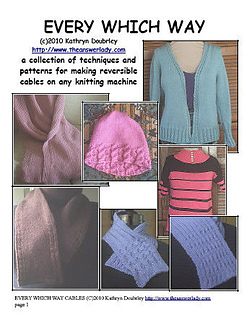patterns >  Every Which Way Reversible Cables
Every Which Way Reversible Cables
> This Way and That Scarf or Shawl


This Way and That Scarf or Shawl
THIS WAY AND THAT SCARF (OR SHAWL)
Wrap it, twist it, tie it. Any way you turn it these cables look the same. Reversible cables look the same from both sides, making them great for scarves, shawls, lapels, turn-down collars and so on. Reversible cabled fabrics are possible by applying cables to some sort of ribbing. In ribbing, the purl side of the fabric hides in the ribs and there are knit stitches on both faces of the fabric. The knit stitches display the cables attractively.
YARN, GAUGE AND MACHINE: Scarf is about 6” wide and 60” long. Shawl is about 15” wide and 60” long. Both may easily be altered to your preferred dimensions by adding or subtracting rows and stitches. Stitches must be added or subtracted in multiples of 4. Row count may be altered freely but the twisted areas must be altered in multiples of 4.
Two gauge are given so the scarf or shawl may be made either on a standard or mid-gauge machine. Mid-gauge machines may often knit either gauge but will not have enough needles to make the Bebe version of the shawl and should use the Nordic version instead. Because the shawl will be draping a ribbed fabric sideways, it will seem to grow beyond the 15” width that it measures laying flat
Exact gauge is not important for this project. Approximate gauges are: 4 stitches/6.25 rows per inch in stockinette using Tamm Nordic at about stitch size 4.1 on both beds for bulikies and a larger size for mid-gauge machines. For standard and mid-gauge & Passap 5mm machines, Tamm Bebe gets about 6.5 stitches/9 rows per inch. On standards and Passaps the stitch size will be about 2 numbers below the maximum. On mid-gauge machines the stitch size will be in the middle of the dial. Adjust the dials so both beds knit at the same gauge, no matter what the numbers read.
The character of the fabric depends on thorough steaming for this project. The pattern is written for the use of a ribber but patient knitters may hand form the rib, then make the twists to get the same effect. Be aware that creating this much ribbing by hand is a lot of work.

- First published: July 2010
- Page created: May 12, 2024
- Last updated: May 20, 2024 …
- visits in the last 24 hours
- visitors right now




